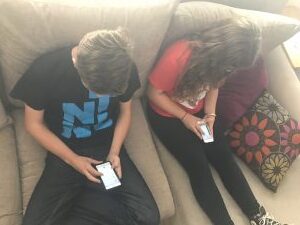Screens and electronic media have become part of our daily lives. They connect us, entertain us and even educate us. This is not necessarily a bad thing, but like all good things they can also be bad for us. Are we too addicted to our screens? How do we raise our children in a time of excessive availability of screens and media? What are the pros and cons? The American Academy of Pediatrics has released guidelines to help families for every age and stage. The good news is, it’s not all bad! Some screen time can actually be beneficial at certain ages.
INFANTS AND TODDLERS UNDER AGE 2

Every aspect of growth and development is occurring rapidly in the first few years of a child’s life. Babies learn language, learn social-emotional skills and develop their motor skills through a variety of play and interaction with adults and caregivers. They develop executive function, which is what helps young children learn self-control, develop a working memory and have cognitive flexibility. This happens through free play and interacting with others. Older children diagnosed with ADHD frequently have very poor executive function skills. Better executive functioning predicts better school performance.
Furthermore, being spoken to directly and read to, helps babies and toddlers learn language. The vocabulary a child enters kindergarten with is related to the amount of language they hear in early childhood. Therefore, in the early years, it is important that children have an ample amount of social connection, interaction and physical free play. They need to hear language in order to learn language and they need to interact with caregivers in order to learn how to interact with their peers.
How do screens interfere with this development? When I counsel families on screen use, I always caution them about what the screens are replacing. Are they replacing learning, bonding, reading, physical play? Under age 2, there will be times that children look at screens. For example, the AAP does not demonize FaceTime or Skype with family members as this constitutes social interaction. Yet due to rapid growth and development, 2 dimensional screens are not recommended for learning. We know that young children learn better when they are spoken to directly, have bi-directional interactions, move their bodies and freely learn the rules of the playground.
PRESCHOOL AGE
Once children turn 2, they are able to interact with screens in an educational way. Only a few apps and television shows have been shown to improve language, cognition and social outcomes. Therefore, when parents are allowing preschool-aged children to use their screens, they need to be aware that not all apps are created equally. In fact, the parent interaction is what is guiding the education of the child. Most apps are not interactive and are not likely to improve learning without parental input. Furthermore, these children still need unstructured play in order to help them develop executive function. Besides a reduction in time to develop executive function, rapidly changing scenes during a television show can impact your child’s ability to pay attention.

While apps and television may have an educational component, especially when an adult is involved, parents again need to consider what the device is replacing. Is the child more sedentary and therefore gaining too much weight? There is data to support the theory that increased screen time increases a child’s risk of obesity. Furthermore, young children are exposed to less-than-healthy food advertising on television. This has been shown to influence their food preferences, typically towards unhealthy options.

There is also the problem with decreased sleep due to screen use. This is true for screen use right before bed and any screen use during the day. Light exposure inhibits the release of melatonin which is needed to initiate sleep.
Finally, it has been shown that background TV results in less face to face communication with children, which translates to them hearing fewer words. To improve your child’s vocabulary by school entry, keep the TV off when they are in the room. And of course, READ to them!

SCHOOL AGED CHILDREN
There are actually many beneficial components to media exposure for children. A lot of positive images can be seen and a lot of social networks can be formed. Children can research school projects online, keep up with current events, find support for an illness or condition, learn healthy habits, be influenced by positive adult role models and keep in touch with long distance friends and family. We know television, tablets, computers and phones are here to stay and in many ways are very necessary. As a parent, I feel much safer knowing I can get in touch with my child during the day or at least track their whereabouts. However, there are also very real risks of media use. As stated above, media use is associated with a higher body mass index, as well as poorer sleep. Children exposed to their screens late at night will have a delayed sleep schedule, making it hard to get up for school. If your child must be on a device for homework, turn down the brightness and change the light from blue light.

There is also the negative impact of media use on mental health. Children can be exposed to cyber bullying, sexting and solicitation. With social media, teens can connect with friends and have meaningful interactions, but they can also experience life dissatisfaction or depression. They are also exposed to images and text that normalize high risk behaviors like sex and drug use. Of course there is also the issue of privacy. Growing up in a connected world means most teens don’t have a good sense of what should remain private and what could come back to haunt them.

PARENTS
Parents have just as much addiction to their screens as kids do. Parents are increasingly getting their news, connections and entertainment on their devices. One look at my Twitter feed and it’s obvious that even as a pediatrician I have a hard time putting my phone down. The problem is, parents of young children are engaging less with their kids. They are distracted at the playground leading young children to engage in riskier behavior. They are looking at their phones at the dinner table instead of engaging their teens. As role models, parents need to partner with their kids to set limits on screen use.

AAP RECOMMENDATIONS
Given everything we know, what is a parent to do? The American Academy of Pediatrics has developed a tool to help parents set rules for their children. Their recommendations include:
- Continuing to limit screen use under 2 years of age except for video messaging
- For 2-5 year old children, limit screen use to 1 hour per day and make the screen time interactive, or at least co-view what the child is watching
- For children 6 years and older, be aware of what they are viewing, monitor for depression or other concerning behavior and make sure screens do not interfere with sleep or physical activity
- Designate screen-free meals, times and locations in the home for everyone
- Discuss with your child how to be a good citizen online and educate them on safety
Make your family media plan today!



